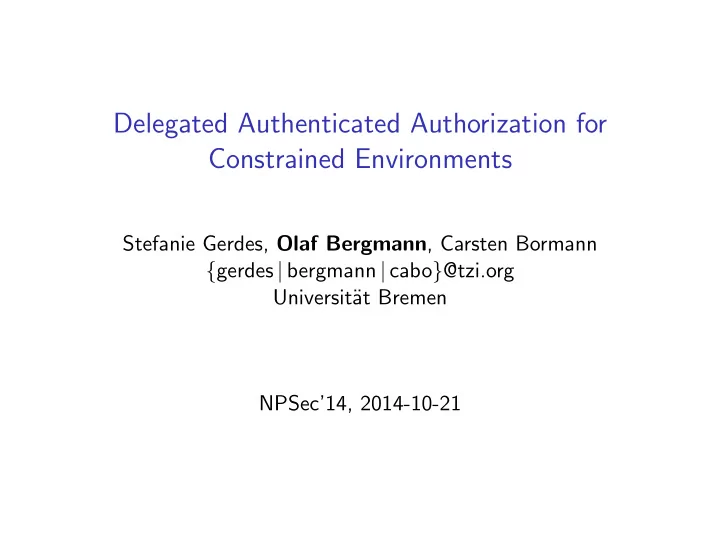

Delegated Authenticated Authorization for Constrained Environments Stefanie Gerdes, Olaf Bergmann , Carsten Bormann { gerdes | bergmann | cabo } @tzi.org Universit¨ at Bremen NPSec’14, 2014-10-21
Motivation ◮ Smart objects ◮ small devices with specific purpose ◮ low cost, limited abilities ◮ Internet of Things ◮ interconnect things and their users to enable new applications ◮ 50 billion connected devices expected by 2020 (Cisco) ◮ Smart objects are expected to be integrated in all aspects of everyday life ◮ entrusted with vast amounts of data important to our lives. ◮ need to communicate unseen and autonomously.
Limitations of “Constrained Environments” ◮ processing power ◮ storage space ◮ network capacities ◮ lack of user interfaces and displays ◮ energy (often powered from primary batteries) ◮ RFC 7228: Terminology for Constrained-Node Networks ◮ device classification ◮ energy profile ◮ sleep strategies
Classes of Constrained Devices Source: RFC 7228
Classes of Constrained Devices Source: RFC 7228
Communication in Constrained Environments ◮ Constrained Application Protocol (CoAP, RFC 7252) ◮ designed for special requirements of constrained environments ◮ Similar to HTTP (RESTful architecture style) ◮ server has items of interest ◮ client requests representation of current state ◮ Datagram Transport Layer Security (DTLS) binding ◮ How can users keep the control over their data and devices? - > Authorization
Problem Statement ◮ A Client (C) wants to access an item of interest, a web resource (R), on a Resource Server (RS). ◮ A priori, C and RS do not know each other, have no trust relationship. They might belong to different owners. ◮ C and / or RS are located on a constrained node.
Goals of an Authenticated Authorization Protocol in Constrained Environments ◮ Secure exchange of authorization information ◮ Establish DTLS channel between constrained nodes ◮ Use only symmetric key cryptography on constrained nodes ◮ Support of class-1 devices ◮ RESTful architectural style ◮ Relieve constrained nodes from managing authentication and authorization
Authenticated Authorization ◮ Determine if the owner of an item of interest allows an entity to access this item as requested. ◮ Authentication: Verify that an entity has certain attributes (cf. RFC4949). ◮ Authorization: Grant permission to an entity to access an item of interest. ◮ Authenticated Authorization: Use the verified attributes to determine if an entity is authorized.
Tasks for Authenticated Authorization ◮ Beforehand: Provide information for Authenticated Authorization ◮ Make attribute-verifier-binding verifiable: Validate that an entity actually has the attributes it claims to have (e.g. that it belongs to a certain user) and bind the attributes to a verifier (e.g. a key) using the endorsement info. ◮ Define access policies (entity with attribute x has this set of permissions). ◮ At the time of the request: Check access request against the provided information ◮ Check the verifier a received access request is bound to. ◮ Check the verifier-attribute binding. ◮ Determine the authorization using the attributes. ◮ Enforce the authorization.
Constrained Level Actors ◮ C and RS are constrained level actors: able to operate on a constrained node. ◮ C attempts to access a resource. ◮ RS hosts one or more resources. ◮ Tasks: ◮ Determine if sender is authorized to access as requested. ◮ Enforce the authorization
Principal Level Actors ◮ C and RS are under control of principals in the physical world. ◮ CO is in charge of C: specifies security policies, e.g. with whom RS is allowed to communicate. ◮ RO is in charge of RS: specifies security policies, e.g. authorization policies.
Security Domains ◮ A priori, C and RS do not know each other, might belong to different security domains
Constraints ◮ C and RS ◮ are constrained in terms of power, memory, storage space. ◮ may not have user interfaces and displays. ◮ can only fulfill a limited number of tasks. ◮ may not have network connectivity all the time. ◮ are not able to manage complex authorization policies. ◮ are not able to manage a large number of keys. ◮ Add another complexity level: less-constrained devices for more difficult tasks
Less-Constrained Level ◮ AM and AS act in behalf of their respective owner. ◮ Tasks: ◮ Obtain the security objectives from their owner. ◮ Authenticate the other party. ◮ Provide simplified authorization rules and means for authentication to their constrained devices.
Unauthorized Access Request
Contact RS’s Less Constrained Device for Authorization
Access Ticket
Use Access Ticket to Establish DTLS Channel
PSK Derivation
RS Permits Authorized Requests Over DTLS
Initial Trust Relationships
Trust: The Complete Picture
Evaluation Reference implementation adds ◮ about 440 Bytes Code ◮ 54 Bytes data for ticket face ◮ 722 Bytes parser for CBOR payload to existing CoAP/DTLS server (ARM Cortex M3).
Summary: The DCAF Protocol ◮ Requires less-contrained nodes to do the hard work (possibly including public-key crypto) ◮ Utilize DTLS to transmit authorization info and access tickets ◮ Authenticate origin client by its access ticket: ◮ RS and AS share at least one session key ◮ AS creates Ticket Face + Verifier, tells AM, C ◮ C initiates DTLS handshake with RS ◮ Ticket Face is PSK identity, Verifier is PSK ◮ RS derives PSK from Ticket Face ◮ Knowledge of Verifier authenticates C to RS! ◮ Knowledge of PSK authenticates RS to C! ◮ Authorization information valid for the entire session ◮ Verifier ensures Face’s integrity
Conclusion ◮ Problem ◮ IoT devices may be too constrained to perform Authenticated Authorization ◮ enable multi-domain scenario ◮ Our solution ◮ Offload complex tasks to less constrained devices ◮ use DTLS with symmetric cryptography for secure communication ◮ Future Work ◮ Demonstrate interworking of less constrained devices, e.g. using OAuth ◮ Define authorization information format for simplified policies
References ◮ http://share.cisco.com/internet-of-things.html ◮ http://tools.ietf.org/rfc/rfc7228 ◮ http://tools.ietf.org/rfc/rfc4949 ◮ https://tools.ietf.org/id/draft-gerdes-ace-dcaf-authorize ◮ http://tools.ietf.org/pdf/draft-gerdes-ace-actors
Recommend
More recommend